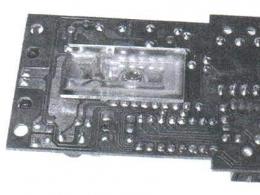Symmetrical transistor multivibrator operation. Transistor multivibrators
Radio circuits for beginner radio amateurs
In this article we present several devices based on one circuit - single-ended multivibrator on transistors of different conductivities.
flasher
Using this diagram you can assemble a device with a flashing light light bulb(see Fig. 1) and apply it for various purposes. For example, install it on a bicycle to power turn lights, or in a lighthouse model, a signal light, or on a car or ship model as a flashing light.
The load of an asymmetrical multivibrator assembled on transistors T1, T2 is light bulb L1. The pulse repetition rate is determined by the capacitance value of capacitor C1 and resistors R1, R2. Resistor R1 limits the maximum flash frequency, and resistor R2 can be used to smoothly change their frequency. You need to start working from the maximum frequency, which corresponds to the top position of the resistor R2 slider in the diagram.
Please note that the device is powered by a 3336L battery, which produces 3.5 V under load, and the L1 light bulb is used at a voltage of only 2.5 V. Will it burn out? No! The duration of its glow is very short, and the thread does not have time to overheat. If the transistors have a high gain, then instead of a 2.5 V x 0.068 A light bulb, you can use a 3.5 V x 0.16 A light bulb. Transistors like MP35-MP38 are suitable for transistor T1, and transistors like MP39-MP42 are suitable for T2.
Metronome
If you install a loudspeaker in the same circuit instead of a light bulb, you will get another device - an electronic metronome. It is used in teaching music, for keeping time during physical experiments, and in photographic printing.
If you slightly change the circuit - reduce the capacitance of capacitor C1 and introduce resistor R3, then the pulse duration of the generator will increase. The sound will increase (Fig. 2). This device can serve as an apartment bell, sound signal model or children's pedal car. (In the latter case, the voltage must be increased to 9 V.) And it can also be used for teaching Morse code. Only then, instead of the Kn1 button, you need to install a telegraph key. The sound tone is selected by capacitor C1 and resistor R2. The larger R3, the louder sound generator However, if its value is more than one kilo-ohm, then oscillations in the generator may not occur.

The generator uses the same transistors as in the previous circuit, and headphones or a head with a coil resistance of 5 to 65 Ohms are used as a loudspeaker.
Humidity indicator
An asymmetrical multivibrator using transistors of different conductivities has an interesting property: during operation, both transistors are either open or locked at the same time. The current consumed by the switched-off transistors is very small. This makes it possible to create cost-effective indicators of changes in non-electrical quantities, such as humidity indicators. The schematic diagram of such an indicator is shown in Figure 3. As can be seen from the diagram, the generator is constantly connected to the power source, but does not work, since both transistors are locked. Reduces current consumption and resistor R4. A humidity sensor is connected to sockets G1, G2 - two thin tinned wires 1.5 cm long. They are sewn to the fabric at a distance of 3-5 mm from each other. The resistance of the dry sensor is high. When wet it falls. The transistors open, the generator starts working. To reduce the volume, you need to reduce the supply voltage or the value of resistor R3. This humidity indicator can be used when caring for newborn babies.

Humidity indicator with sound and light signal
If you expand the circuit a little, the humidity indicator will emit light simultaneously with the sound signal - light bulb L1 will start to light up. In this case, as can be seen from the diagram (Fig. 4), two asymmetrical multivibrators on transistors of different conductivities are installed in the generator. One is assembled on transistors T1, T2 and is controlled by a humidity sensor connected to sockets G1, G2. The load of this multivibrator is lamp L1. The voltage from the collector T2 controls the operation of the second multivibrator, assembled on transistors T3, T4. It works like a generator audio frequency, and loudspeaker Gr1 is turned on at its output. If there is no need to give a sound signal, then the second multivibrator can be turned off.

The transistors, lamp and loudspeaker used in this humidity indicator are the same as in previous devices.
Siren simulator
Interesting devices can be built using the dependence of the frequency of an asymmetrical multivibrator on transistors of different conductivity on the base current of transistor T1. For example, a generator that simulates the sound of a siren. Such a device can be installed on a model of an ambulance, fire truck, or rescue boat.
The schematic diagram of the device is shown in Figure 5. In the initial position, the Kn1 button is open. Transistors are locked. The generator is not working. When the button is closed, capacitor C2 is charged through resistor R4. The transistors open and the multivibrator starts working. As capacitor C2 charges, the base current of transistor T1 increases and the frequency of the multivibrator increases. When the button is opened, everything repeats in the reverse order. The siren sound is simulated by periodically closing and opening the button. The rate of rise and fall of sound is selected by resistor R4 and capacitor C2. The siren tone is set by resistor R3, and the sound volume by selecting resistor R5. The transistors and loudspeaker are selected the same as in previous devices.

Transistor tester
Considering that this multivibrator uses transistors of different conductivities, you can use it as a device for testing transistors by replacement. The schematic diagram of such a device is shown in Figure 6. The circuit of a sound generator is taken as a basis, but a light pulse generator can be used with equal success.

Initially, by closing the Kn1 button, check the operation of the device. Depending on the type of conductivity, connect the transistor under test to sockets G1 - G3 or G4-G6. In this case, use switch P1 or P2. If there is sound in the loudspeaker when you press the button, then the transistor is working.
As switches P1 and P2, you can take toggle switches with two switching contacts. The figure shows the switches in the "Control" position. The device is powered by a 3336L battery.
Sound generator for testing amplifiers
Based on the same multivibrator, you can build a fairly simple generator for testing receivers and amplifiers. Its circuit diagram is shown in Figure 7. Its difference from a sound generator is that instead of a loudspeaker, a 7-step voltage level regulator is switched on at the output of the multivibrator.

E. TARASOV
Rice Y. CHESNOKOBA
YUT For skillful hands 1979 No. 8
Multivibrator
Schematic diagram of the “classical” simplest transistor multivibrator
Multivibrator- relaxation signal generator of electrical rectangular oscillations with short fronts. The term was proposed by the Dutch physicist van der Pol, since the oscillation spectrum of a multivibrator contains many harmonics - in contrast to a sinusoidal oscillation generator (“monovibrator”).
Bistable multivibrator
A bistable multivibrator is a type of standby multivibrator that has two stable states characterized by different output voltage levels. As a rule, these states are switched by signals applied to different inputs, as shown in Fig. 3. In this case, the bistable multivibrator is an RS type flip-flop. In some circuits, a single input is used for switching, to which pulses of different or the same polarity are supplied.
In addition to performing the trigger function, a bistable multivibrator is also used to build oscillators synchronized with an external signal. This type of bistable multivibrators is characterized by a minimum residence time in each state or a minimum oscillation period. Changing the state of the multivibrator is possible only after a certain time has passed since the last switching and occurs at the moment the synchronizing signal is received.
In Fig. Figure 4 shows an example of a synchronized oscillator made using a synchronous D flip-flop. The multivibrator switches when there is a positive voltage drop at the input (along the edge of the pulse).
is a pulse generator of almost rectangular shape, created in the form of an amplifying element with a positive-feedback circuit. There are two types of multivibrators.
The first type is self-oscillating multivibrators, which do not have a stable state. There are two types: symmetrical - its transistors are the same and the parameters of the symmetrical elements are also the same. As a result, the two parts of the oscillation period are equal to each other, and the duty cycle is equal to two. If the parameters of the elements are not equal, then it will already be an asymmetrical multivibrator.
The second type is waiting multivibrators, which have a state of stable equilibrium and are often called a single-vibrator. The use of a multivibrator in various amateur radio devices is quite common.
Description of the operation of a transistor multivibrator
Let us analyze the operating principle using the following diagram as an example.
It is easy to see that it practically copies the circuit diagram of a symmetrical trigger. The only difference is that connections between switching blocks, both direct and reverse, are carried out according alternating current, and not on a constant basis. This radically changes the features of the device, since in comparison with a symmetrical trigger, the multivibrator circuit does not have stable equilibrium states in which it could remain for a long time.
Instead, there are two states of quasi-stable equilibrium, due to which the device is strictly in each of them certain time. Each such period of time is determined by transient processes occurring in the circuit. The operation of the device consists of a constant change in these states, which is accompanied by the appearance at the output of a voltage very similar in shape to a rectangular one.
Essentially, a symmetrical multivibrator is a two-stage amplifier, and the circuit is constructed so that the output of the first stage is connected to the input of the second. As a result, after applying power to the circuit, it is sure that one of them is open and the other is in a closed state.
Let's assume that transistor VT1 is open and is in a state of saturation with current flowing through resistor R3. Transistor VT2, as mentioned above, is closed. Now processes occur in the circuit associated with the recharging of capacitors C1 and C2. Initially, capacitor C2 is completely discharged and, following the saturation of VT1, it is gradually charged through resistor R4.

Since capacitor C2 bypasses the collector-emitter junction of transistor VT2 through the emitter junction of transistor VT1, its charging rate determines the rate of change in voltage at the collector VT2. After charging C2, transistor VT2 closes. The duration of this process (the duration of the collector voltage rise) can be calculated using the formula:
t1a = 2.3*R1*C1
Also in the operation of the circuit, a second process occurs, associated with the discharge of the previously charged capacitor C1. Its discharge occurs through transistor VT1, resistor R2 and the power source. As the capacitor at the base of VT1 discharges, a positive potential appears and it begins to open. This process ends after C1 is completely discharged. The duration of this process (pulse) is equal to:
t2a = 0.7*R2*C1
After time t2a, transistor VT1 will be off, and transistor VT2 will be in saturation. After this, the process will be repeated according to a similar pattern and the duration of the intervals of the following processes can also be calculated using the formulas:
t1b = 2.3*R4*C2 And t2b = 0.7*R3*C2
To determine the oscillation frequency of a multivibrator, the following expression is valid:
f = 1/ (t2a+t2b)

Portable USB oscilloscope, 2 channels, 40 MHz....
This article describes a device designed simply so that a novice radio amateur (electrician, electronics engineer, etc.) can better understand circuit diagrams and gain experience during assembly of this device. Although it is possible that this simplest multivibrator, which is described below, can also be found practical use. Let's look at the diagram:
Picture 1 - The simplest multivibrator on the relay
When power is applied to the circuit, the capacitor begins to charge through resistor R1, the contacts K1.1 are open, when the capacitor is charged to a certain voltage, the relay will operate and the contacts close, when the contacts are closed, the capacitor will begin to discharge through these contacts and resistor R2, when the capacitor is discharged to a certain voltage, the contacts will open and the process will then be repeated cyclically. This multivibrator works because the relay operating current is greater than the holding current. The resistance of the resistors CANNOT be changed within wide limits and this is a disadvantage of this circuit. The resistance of the power supply affects the frequency and because of this, this multivibrator will not work from all power sources. The capacitance of the capacitor can be increased, but the frequency of contact closure will decrease. If the relay has a second group of contacts and large capacitance values are used, then this circuit can be used to periodically automatically turn on/off devices. The assembly process is shown in the photos below:

Connecting resistor R2

Connecting a capacitor

Connecting resistor R1

Connecting the relay contacts to its winding

Connecting wires for power supply

You can buy a relay at a radio parts store or get it from old broken equipment. For example, you can desolder relays from boards from refrigerators:
If the relay has bad contacts, you can clean them a little.

If you look at it, all electronics consists of a large number of individual bricks. These are transistors, diodes, resistors, capacitors, inductive elements. And from these bricks you can build anything you want.
From a harmless children's toy that makes, for example, the sound of “meow”, to the guidance system of a ballistic missile with a multiple warhead for eight megaton charges.
One of the very well-known and often used circuits in electronics is a symmetrical multivibrator, which is a electronic device producing (generating) vibrations in shape, approaching rectangular.
The multivibrator is assembled on two transistors or logic circuits With additional elements. Essentially this is a two-stage amplifier with a positive circuit feedback(POS). This means that the output of the second stage is connected through a capacitor to the input of the first stage. As a result, the amplifier turns into a generator due to positive feedback.
In order for the multivibrator to start generating pulses, it is enough to connect the supply voltage. Multivibrators can be symmetrical And asymmetrical.
The figure shows a circuit of a symmetrical multivibrator.

In a symmetrical multivibrator, the values of the elements of each of the two arms are absolutely the same: R1=R4, R2=R3, C1=C2. If you look at the oscillogram of the output signal of a symmetrical multivibrator, it is easy to notice that the rectangular pulses and pauses between them are the same in time. t pulse ( t and) = t pause ( t p). Resistors in the collector circuits of transistors do not affect the pulse parameters, and their value is selected depending on the type of transistor used.

The pulse repetition rate of such a multivibrator is easily calculated using a simple formula:
Where f is the frequency in hertz (Hz), C is the capacitance in microfarads (µF) and R is the resistance in kilo-ohms (kOhm). For example: C = 0.02 µF, R = 39 kOhm. We substitute it into the formula, perform the actions and get a frequency in the audio range approximately equal to 1000 Hz, or more precisely 897.4 Hz.
In itself, such a multivibrator is uninteresting, since it produces one unmodulated “squeak”, but if the elements select a frequency of 440 Hz, and this is the A note of the first octave, then we will get a miniature tuning fork, with which you can, for example, tune a guitar on a hike. The only thing you need to do is add a single transistor amplifier stage and a miniature speaker.
The following parameters are considered to be the main characteristics of a pulse signal:
Frequency. Unit of measurement (Hz) Hertz. 1 Hz – one oscillation per second. Frequencies perceived by the human ear are in the range of 20 Hz – 20 kHz.
Pulse duration. It is measured in fractions of a second: miles, micro, nano, pico and so on.
Amplitude. In the multivibrator under consideration, amplitude adjustment is not provided. Professional devices use both step and smooth amplitude adjustment.
Duty factor. The ratio of the period (T) to the pulse duration ( t). If the pulse length is 0.5 periods, then the duty cycle is two.

Based on the above formula, it is easy to calculate a multivibrator for almost any frequency with the exception of high and ultra-high frequencies. There are slightly different physical principles at work there.
In order for the multivibrator to produce several discrete frequencies, it is enough to install a two-section switch and five or six capacitors of different capacities, naturally identical in each arm, and use the switch to select the required frequency. Resistors R2, R3 also affect the frequency and duty cycle and can be made variable. Here is another multivibrator circuit with adjustable switching frequency.

Reducing the resistance of resistors R2 and R4 to less than a certain value, depending on the type of transistors used, can cause generation failure and the multivibrator will not work, therefore, in series with resistors R2 and R4, you can connect a variable resistor R3, which can be used to select the switching frequency of the multivibrator.
The practical applications of a symmetrical multivibrator are very extensive. Pulse Computer Engineering, radio measuring equipment in production household appliances. A lot of unique medical equipment is built on circuits based on the same multivibrator.
Due to its exceptional simplicity and low cost, the multivibrator has found wide application in children's toys. Here is an example of a regular LED flasher.

With the values of electrolytic capacitors C1, C2 and resistors R2, R3 indicated in the diagram, the pulse frequency will be 2.5 Hz, which means the LEDs will flash approximately twice per second. You can use the circuit proposed above and include a variable resistor together with resistors R2, R3. Thanks to this, it will be possible to see how the flash frequency of the LEDs will change when the resistance of the variable resistor changes. You can install capacitors of different ratings and observe the result.
While still a schoolboy, I assembled a Christmas tree garland switch using a multivibrator. Everything worked out, but when I connected the garlands, my device began to switch them with a very high frequency. Because of this, the TV in the next room began to show wild interference, and the electromagnetic relay in the circuit crackled like a machine gun. It was both joyful (it works!) and a little scary. The parents were quite alarmed.
Such an annoying mistake with too frequent switching did not give me peace. And I checked the circuit, and the capacitors were at their nominal value. I didn't take into account only one thing.
The electrolytic capacitors were very old and dried out. Their capacity was small and did not at all correspond to what was indicated on their body. Due to the low capacity, the multivibrator worked at more high frequency and switched the garlands too often.
At that time I did not have instruments that could measure the capacitance of capacitors. Yes, and the tester used a pointer, and not a modern digital multimeter.
Therefore, if your multivibrator produces an excessive frequency, then first check the electrolytic capacitors. Fortunately, now you can buy a universal radio component tester for little money, which can measure the capacitance of a capacitor.






